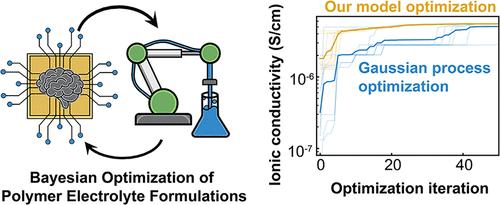Autonomous Discovery of Polymer Electrolyte Formulations with Warm-Start Batch Bayesian Optimization
IF 7
2区 材料科学
Q2 CHEMISTRY, PHYSICAL
引用次数: 0
Abstract
Solid polymer electrolytes are a promising class of materials to enable next-generation Li-based batteries. They offer highly tunable properties, scalable processing conditions, and increased safety. However, current solid polymer electrolytes do not have sufficient ionic conductivity for room-temperature battery applications. The discovery of novel polymers and the optimization of polymer-salt formulations with high ionic conductivity are critical bottlenecks in developing new polymer-based batteries. Programmable laboratories driven by machine learning algorithms have been proposed to power accelerated discovery cycles. Here we demonstrate a closed-loop, machine-learning driven Bayesian optimization pipeline for optimizing a dry polymer electrolyte composed of poly(ϵ-caprolactone) (PCL) electrolyte with one of 18 lithium salts. We use previously collected literature data to warm-start our optimization and achieve high performance while following through with a novel high-exploration batch-based sampling method. Formulations chosen by the sampling method were mixed, cast, dried, and characterized on an autonomous high-throughput polymer electrolyte platform. After five batches of optimization conducted in just over a month, we discovered formulations with ionic conductivity that were on par with top-performing poly(ethylene oxide) electrolytes, the standard of the field.

基于热启动批量贝叶斯优化的聚合物电解质配方自主发现
固体聚合物电解质是实现下一代锂基电池的一种很有前途的材料。它们提供高度可调的特性、可扩展的处理条件和更高的安全性。然而,目前的固体聚合物电解质在室温电池应用中没有足够的离子电导率。新型聚合物的发现和高离子电导率聚合物盐配方的优化是开发新型聚合物基电池的关键瓶颈。由机器学习算法驱动的可编程实验室被提议加速发现周期。在这里,我们展示了一个闭环,机器学习驱动的贝叶斯优化管道,用于优化由聚(ϵ-caprolactone) (PCL)电解质与18种锂盐之一组成的干聚合物电解质。我们使用先前收集的文献数据来预热我们的优化并实现高性能,同时采用了一种新的高勘探批次抽样方法。通过采样方法选择的配方进行混合、铸造、干燥,并在自主高通量聚合物电解质平台上进行表征。在一个多月的时间里进行了五批优化后,我们发现了离子电导率与高性能聚环氧乙烷电解质(该领域的标准)相当的配方。
本文章由计算机程序翻译,如有差异,请以英文原文为准。
求助全文
约1分钟内获得全文
求助全文
来源期刊

Chemistry of Materials
工程技术-材料科学:综合
CiteScore
14.10
自引率
5.80%
发文量
929
审稿时长
1.5 months
期刊介绍:
The journal Chemistry of Materials focuses on publishing original research at the intersection of materials science and chemistry. The studies published in the journal involve chemistry as a prominent component and explore topics such as the design, synthesis, characterization, processing, understanding, and application of functional or potentially functional materials. The journal covers various areas of interest, including inorganic and organic solid-state chemistry, nanomaterials, biomaterials, thin films and polymers, and composite/hybrid materials. The journal particularly seeks papers that highlight the creation or development of innovative materials with novel optical, electrical, magnetic, catalytic, or mechanical properties. It is essential that manuscripts on these topics have a primary focus on the chemistry of materials and represent a significant advancement compared to prior research. Before external reviews are sought, submitted manuscripts undergo a review process by a minimum of two editors to ensure their appropriateness for the journal and the presence of sufficient evidence of a significant advance that will be of broad interest to the materials chemistry community.
 求助内容:
求助内容: 应助结果提醒方式:
应助结果提醒方式:


